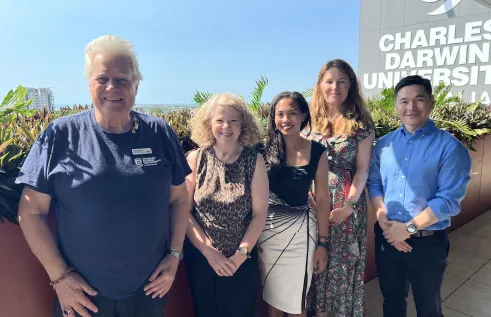CDU researcher studies how hate speech becomes acts of terror
A new Charles Darwin University (CDU) study on the writings of two of the world’s most infamous terrorists could help authorities to identify how topics, schemas and strategies of hate speech are used to incite violence.
The role of (de)bonding in the legitimation of violence in extremists' public threatening communication, published in the Systemic Functional Linguistics Theory and Application in Global Contexts, uses forensic linguistics, which is the use of linguistic techniques to investigate crimes, to examine terrorist language used to mobilise support and legitimise harm.
The study by Charles Darwin University (CDU) Linguistics Lecturer Dr Awni Etaywe analysed inciting texts and messages by Osama bin Laden and Christchurch Mosque gunman Brenton Tarrant.
The analysis revealed both individuals used bonds — relationships between people or groups based on shared experiences and feelings— to construct a ‘We/They’ division, in which the ‘We’ is used to legitimise violence and delegitimise the opposing actions and beliefs of the ‘They’.
Dr Etaywe said both individuals used rhetorical strategies and in particular ethos and logos, the appeal to values and authority and the appeal to reason respectively, to persuade the actions and beliefs of the ‘They’ as a threat to the land, resources and ideology of the ‘We’.
“The two terrorists shared a similar style of persuasion, which can be linked to the purpose of their texts, as well as to their violent beliefs and agendas. Both terrorists wanted to bring about social and political change through violence.
“Each terrorist often viewed the world and relationships between different groups in black-and-white terms, and constantly criticised and saw other groups in a negative light while praising their own group and its actions.
“Establishing connections between shared beliefs and incited violence through ethical arguments serves to present the inciter as a more trustworthy person. It serves to position the addressed audiences to believe that the critique is coming from someone with strong ethics and competence who shares ‘Our’ values.
Dr Etaywe said this breakdown of language supports the argument that language reveals a terrorist’s ideological pattern of thought and behaviour and could help authorities in terrorist threat assessments.
“This in-depth semantic analysis, which attends to shared bonds, critique and rhetorical strategies, offers forensic linguists a way to study extremist language that promotes hate and violence,” Dr Etaywe said.
“It helps us better understand the ideas behind encouraging hatred and violence and improves our ability to detect extremists’ topics, schemas and linguistic methods leveraged in incitement.”
Related Articles

CDU Free Tax Clinic a finalist for prestigious award
Charles Darwin University’s (CDU) Free Tax Clinic has been named one of five finalists for Shaping Australia’s 2025 Community Champion Award.
Read more about CDU Free Tax Clinic a finalist for prestigious award
New education hub launches to train more First Nations teachers
Charles Darwin University (CDU) has officially launched the First Nations Training and Teacher Education Hub, a collaborative initiative designed to grow the next generation of First Nations teachers, educators, and leaders across the Northern Territory.
Read more about New education hub launches to train more First Nations teachers
Social media subjecting Black women to radicalised digital policing
Influencers use oppression, manipulation and weaponisation to police Black women on social media, according to new research uncovering the entrenched nature of digital racism.
Read more about Social media subjecting Black women to radicalised digital policing
